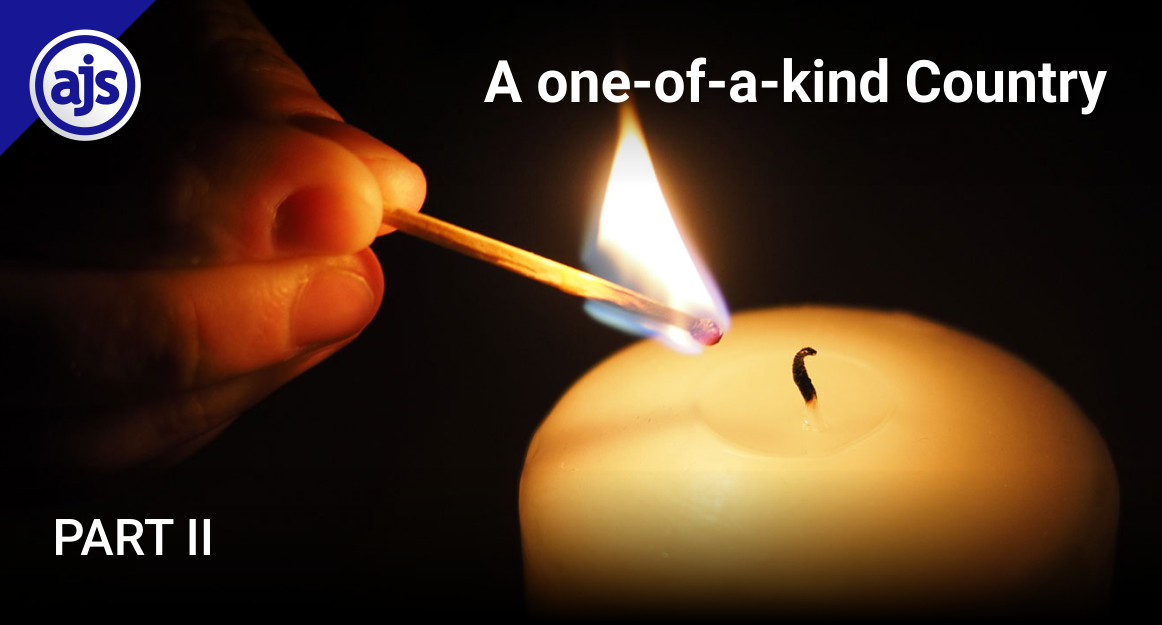
A one-of-a-kind Country: Part II
Load shedding – a perspective…
“Oh no. Not another seditious article on the woes of load shedding” – You must be thinking.
You have heard it all before.
Sure. We hear you. And we agree.
But this is a slightly different take….
South Africans are becoming old hats at this “load shedding” debacle having been placed on planned power outages since 2007.
It has seemingly become a begrudged part of day-to-day life. Bleak and disappointing costing an estimated “R500 million per stage, per day and the Western Cape’s economy R75 million per stage, per day”. And that was in 2020 (MEC Anton Bredell on ESKOM stage 4 load shedding).
But load shedding is part of our collective reality. Something we have had to get used to. Something that doesn’t have an expiry date any time soon.
It seems like a hopeless situation. And it would be – if we weren’t South African.
The Worldwide Energy Crisis
It wasn’t long ago that the rest of the world thought that load shedding meant to shed some extra kgs. A type of fad crash diet. Now, load shedding has found its way into dictionaries, like the Oxford English Dictionary –
“Load-shedding (noun)
the practice of stopping the supply of electricity for a period of time because the demand is greater than the supply”.
Sami Hall has also done a marvellous job of explaining – in a truly South African way – what load shedding means –
“Cutting off our electricity for a few hours, every few hours just to make sure that we take the time to appreciate the small things like burning a candle and smelling the roses…”
And that’s just so… South African. Poking fun at a serious matter and illustrating just how we “get on with things”. Often with a shrug, a tear but also a great big laugh.
But the Energy Crisis in South Africa isn’t limited to the African shores. In a strange twist of fate, energy is in short supply – everywhere.
The United States
As set out in Oilprice.com, the United States is facing its own energy crisis –
“From the blowing up of the Nord Stream pipeline system in the Baltic Sea (in NATO’s backyard) to reduced Russian natural gas flows to Europe to soaring US liquefied natural gas (LNG) exports to Europe, natural gas markets will be very tight everywhere this winter.
A double whammy at the gas pump and utility bill should stoke discontent with many Americans who’ve been battered by high inflation under the Biden administration as the Federal Reserve attempts to quell high prices with aggressive interest rate hikes that could plunge households into even more financial chaos by stoking a 2023 recession.”
Discontent harbours ill intention towards leadership. It would seem.
The European Continent
Europe has not gone unscathed either.
Europe is facing a deepening energy crisis as it prepares for a cold winter. Gas prices have reached record highs, and supplies are running low (Aljazeera).
Reuter’s article titled Putin blames Europe for energy crisis as price cap divides EU sets out the following –
“The Nord Stream gas link to Germany is now out of action after a leak last month that both Russia and the West have blamed on sabotage, without identifying who was behind it.
Putin said gas could still be supplied by one intact part of the Nord Stream 2 pipeline, but it was up to the EU whether or not it wanted the gas.
Germany froze the Nord Stream 2 project days before Russia sent troops into Ukraine and a German government spokesperson on Wednesday ruled out taking gas via that route.
The impact of efforts to use less Russian energy, plus steep cuts in supplies from Russia, have been felt across the 27-nation EU, with gas prices almost 90% higher than a year ago and fears of rationing and power cuts over the coming winter.”
It is worth noting two further facts –
1. Russia previously supplied about 40% of the EU’s gas consumption by pipeline, and those exports have already been cut by 75% (Aljazeera), and
2. In Poland, a leak was detected in a section of the Druzhba oil pipe around 70 kms (43 miles) from the central Polish city of Plock. The Druzhba pipeline, is one of the world’s largest, supplying Russian oil to much of central Europe (Reuters).
Meanwhile Germany – who had planned some heavy spending to shield its citizens from the full impact of soaring energy costs has caused unease among some countries in the 27-nation EU that say what Germany (a wealthier EU country) intends to spend is more than poorer members can afford. But it is also where Germany intends to get the vast quantities of cash to fund the energy costs that has raised a few eyebrows. Germany suggested EU states could use money from the 800 billion euro ($778 billion) “Next Generation” pandemic recovery fund to help tackle other crises, such as the energy crisis (Germans told to unite over energy crisis amid EU divisions).
And that has left a lot of countries within the EU feeling ill at ease.
But it’s no surprise that Germany would be clutching at the next generation pandemic straws. According to Clean Energy Wire, “The European energy crisis is set to push Germany into a recession in 2023”. Something any country coming out of the pandemic would want to avoid at all costs.
Whether an agreement will be reached amidst threats of nuclear retaliation and an ongoing war in Ukraine leaves a very big question mark over whether households will remain warm during the European Winter or whether Europeans will also need to embrace a “do or die” South African attitude investing in bulk candles, rechargeable LED lights and lots and lots of firewood.
The United Kingdom
Our “experience” with load shedding will provide a (excuse the pun) shining beacon for Brits. The UK will be getting a crash course in load shedding as they plan for 4 days of load shedding in January 2023 – “if several things go wrong” (Business Insider).
Experts within the UK are looking to South Africa for the implications of load shedding, including mental health issues faced due to power cuts. This may involve policies instituted by the UK Government forcing businesses to shoulder a greater portion of forced power cuts, so that citizens may escape “the despair of the lights going out”.
With the energy crisis over the EU and the UK’s heads its fair to say that “all roads lead to Russia”. Seemingly, Christmas Carols by candlelight will have a whole new meaning this year.
What is South Africa doing about load shedding?
South Africa relies on coal for more than 80% of its power. Making South Africa the world’s 13th-biggest source of planet-warming gases. Something wealthier nations (like the US, UK, France, and Germany) are trying to avoid by looking to donate $8.5 billion (R152 billion) to help wean South Africa off its reliance on coal – “The Climate Finance Deal”. (R152bn deal at risk amid fraught talks between rich countries).
But with Mineral Resources and Energy Minister Gwede Mantashe stating that the African continent “cannot be dictated to regarding its energy transition” (Fossil fuels kill, but hunger kills faster, Mantashe tells conference) and with talks on the Climate Finance Deal on the proverbial rocks due to SA pushing for cheaper money in the form of grants and low-interest loans but failing to give more detail about how the loan will be spent (News24), we need an alternative.
On 25 July 2022, President Cyril Ramaphosa set out the following 10-point plan to solve the energy crisis in South Africa –
1. A complete scrapping of licensing requirements for private energy projects that feed into the grid;
2. Eskom will buy electricity from existing independent power producers (IPPs);
3. Eskom will import power from Botswana and Zambia;
4. The amount of new generation capacity procured through Bid Window 6 for wind and solar power will be doubled from 2 600 MW to 5 200 MW. Further bid windows will be released “on an expedited basis”;
5. Special legislation will be tabled in Parliament to address the legal and regulatory obstacles to new generation capacity “for a limited period” i.e. doing away with red tape;
6. Eskom has been given permission to increase its budget over the next 12 months for critical maintenance (despite a debt burden of almost R400 billion. There is a plan in place for SA’s Treasury to take over a portion of Eskom’s debt to place it on a sustainable footing);
7. Businesses and households will be encouraged to install rooftop solar and to connect this to the grid, with a feed-in tariff as an incentive;
8. Eskom will be constructing its first solar and battery storage projects at Komati, Majuba, Lethabo and several other power stations, resulting in over 500MW being added to the system;
9. A National Energy Crisis Committee, chaired by the director-general Phindile Baleni, will bring together all the departments and entities involved in the provision of electricity, and
10. SAPS has set up a special law enforcement team to help Eskom confront crime and corruption (Ramaphosa’s 10-point power crisis plan).
According to Professor Sampson Mamphweli, the director of Stellenbosch University’s Centre for Renewable and Sustainable Energy Studies, the main issue facing Eskom is the continued breakdown of coal-fired power stations (due to neglect) but that the “measures announced by the president will ease load shedding in the short to medium term, and [load shedding] will be a thing of the past in the next two years.” (News24).
Mineral Resources and Energy Minister Gwede Mantashe on 12 October told the 2022 Windaba in Cape Town that South Africa should “shift to an energy mix of renewables coupled with nuclear until wind and solar can provide affordable energy at scale” (Nuclear coupled with renewables is ideal for SA, says Mantashe). In other words – this will take time.
Meanwhile, 3 wind energy projects from Bid Window 5, all to be developed by French multinational Électricité de France (EDF) have reached new milestones after several agreements were recently signed. But these EDF projects (once they reach financial close), will take an estimated 24 months to complete. Which means capacity will only be online by December 2024 (Three wind projects worth R11bn signed off).
The Bid Window 5 of the Renewable Independent Power Producer Programme (REIPPP) – of which there are 25 IPP’s in total – should secure 2 583MW of generation capacity which will contribute to plugging the 4 000MW to 6 000MW capacity gap (News24).
At this stage, it seems that there is a lot on the go – between the critical maintenance of the current neglected power stations, to signing off the Bid Window 5 IPP’s agreements and bringing forward Bid Window 6, to buying power from Botswana and Zambia whilst also trying to secure the Climate Finance Deal which seeks to “allow some of South Africa’s coal-fired plants to close and be repurposed to produce renewable energy, with some funding also available to expand the national power grid in a country that suffers regular blackouts” (News24).
There’s a lot on the line here!
With South African’s waiting (not with bated breath) to see how this will all pan out, we currently prepare for Stage 2 Load Shedding.
What you can do
While South African’s are still left in the dark, (at least some of the time), we need to look to our resilience and our determination to stay positive –
Ø Installing your own household solar panels (making good on the feed-in tariff).
Ø Investing in inverters (with a 12-hr. minimum capacity) and generators which are “life savers” when you suddenly find yourself without power (not scheduled load shedding) because your local substation has shut down.
Ø Bring and braai’s together with bring your own candle get-togethers.
Ø The use of gas in the kitchen is also a top tip or at least have a braai on the patio (you need to cook, right?). Investing in tons of ice to keep your food (and your Castle LITE or Zamalek) cold are crucial.
Ø Bulk purchasing candles and LED rechargeable lights has also become a NECESSITY.
Ø Downloading books on your iPad or kindle or if you prefer the physicality of a hard-back book, there are tons of secondhand stores where you can find some fantastic novels in excellent condition (at half price).
Ø Staying in touch with family and friends. We all love a “good kuier”. Even family drama makes for “interesting conversation”.
Ø And when all else fails – some South African jokes will do the trick.
What are you doing to stay sane?
South Africa is truly a one-of-a-kind country (that is sometimes in the dark) with amazingly unique people.
Viva South Africa, Viva!
– Written by Alicia Koch on behalf of AJS





Pingback: A one-of-a-kind Country: Part III - AJS South Africa